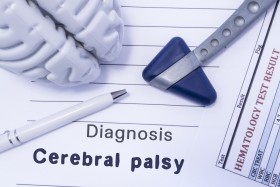Cerebral Palsy Symptoms in Babies

Out of all the different types of birth injuries out there, cerebral palsy is one of the most common. It’s estimated that about 764,000 children and adults in the United States have cerebral palsy. It occurs in about three out of every thousand live births.
Cerebral palsy isn’t always easy to diagnose right away. In severe cases, it can be diagnosed shortly after birth, but It’s more commonly diagnosed between the ages of 18 months and 24 months. When children are that young, it’s not easy for them to communicate that something is wrong, so it’s important for parents and caregivers to know the signs to watch for.
As we talk about cerebral palsy, it’s important to understand that it doesn’t refer to one specific condition. There are a few different types of cerebral palsy and the symptoms a child shows can vary depending on the type of cerebral palsy they have. It’s also possible for a child to have mixed cerebral palsy, which can result them showing a combination of different types of cerebral palsy.
Spastic Cerebral Palsy
Spastic cerebral palsy is the most common type of cerebral palsy, accounting for over 70% of all cases of cerebral palsy. This type of cerebral palsy is typically marked by muscle spasms or muscle tightness. Spastic cerebral palsy can be broken down even further into three different types: spastic diplegia, spastic hemiplegia, and spastic quadriplegia.
With spastic diplegia, the muscle problems will be located in the legs, resulting in problems like legs turning inward at the knees and making it difficult to walk correctly. Spastic hemiplegia impacts one side of the body and can cause one arm or leg to be shorter than the other. When legs are impacted, a child might tend to walk on their tiptoes. Scoliosis, seizures, speech problems, and vision problems are all also associated with spastic hemiplegia. Spastic quadriplegia is the most serious type of spastic cerebral palsy, impacting all limbs and other parts of the body. A child with spastic quadriplegia might show symptoms like muscle tremors, muscle spasms, tight muscle tone, cognitive disabilities, seizures, and speech impediments.
Dyskinetic Cerebral Palsy
Dyskinetic cerebral palsy involves abnormal, uncontrolled muscle movements, but tends to be less spastic than spastic cerebral palsy. A child with dyskinetic cerebral palsy might also have an unusual posture, poor coordination, unusually slow or fast movements. It could also impact muscles in the face or mouth.
This type of cerebral palsy can also be broken down into different types: athetoid, choreoathetoid, and dystonic. In dystonic cases, you might see more repetitive, twisting motions with abnormal muscle tone, whereas athetoid is typically marked by slow, writhing movements. Choreoathetoid, on the other hand, tends to involve less controlled, unpredictable movements.
Ataxic Cerebral Palsy
Ataxic cerebral accounts for about 2.6% of all cases of cerebral palsy. Since this type of cerebral palsy impacts the cerebellum, which controls balance and coordination, people with this type of palsy often have poor coordination or muscle tremors that make it hard for them to walk or write.
Cerebral palsy is just one a few types of palsy that can occur around the time of birth. Whether your child developed cerebral palsy, Erb’s palsy, or Klumpke’s palsy, it’s best to contact a birth trauma lawyer as soon as possible. In many cases, palsies are the result of a medical error and it’s important to learn about what legal options are open to you. At Goodwin & Scieszka, we have attorneys experience in handling birth trauma cases. Contact us to learn how we can help you.






